Detailed Deadlift Program for Boosting Your 1RM
Author:
Unlock your full potential by engaging with our experts and community! Have questions about your fitness journey or looking for expert advice on weightlifting techniques? Don’t hesitate — leave a comment below and Oleksiy Torokhtiy will provide a personalized answer and insights to help you reach your goals.
Torokhtiy is reader-supported. Some links are affiliate links, and we may earn a commission at no extra cost to you. See our disclosure page for details.
Are you striving to improve your deadlift? Want to build lean muscle mass, power, and stamina? Are you a novice at this compound exercise?
No need to rush and run to a random gym and climb out of your skin to squeeze out the maximum of your capabilities. Entrust your training regime and skilling up your deadlift to proficient Oly lifters.
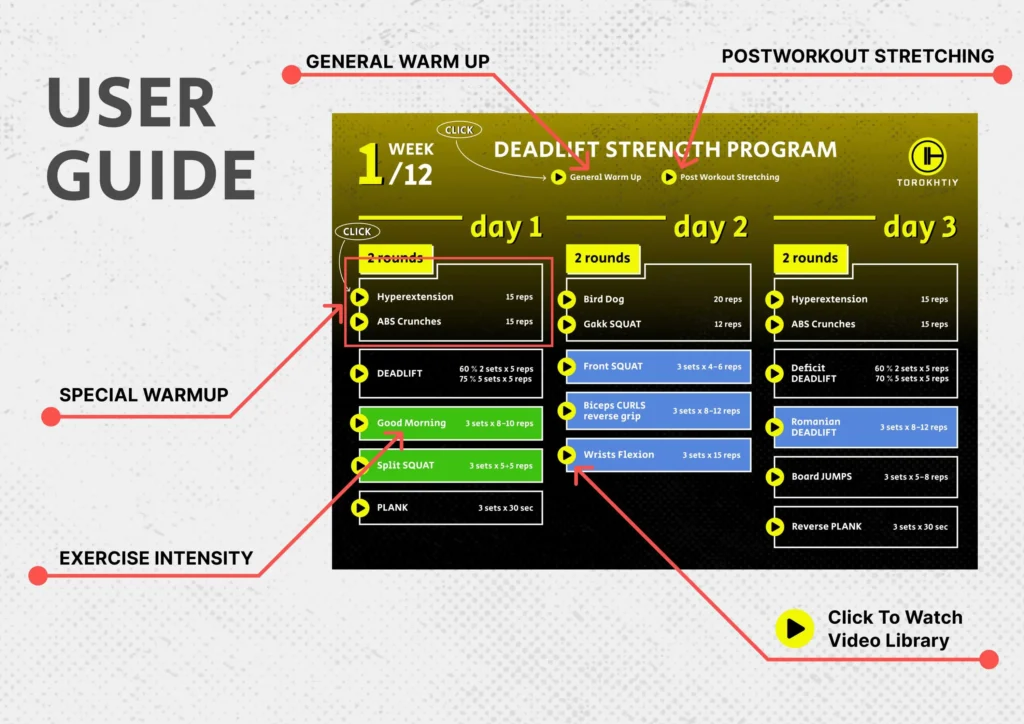
That is why we are here! We will pick up the proper combination of workout exercise options to develop your general strength and enhance your deadlift progression in the shortest time possible.
The deadlift training program allows you to increase your RM performance quantitatively and qualitatively, gradually improving your lifting performance based on your body weight and gender. Regardless of your fitness level, join the deadlift training plan to load the bar with heavier weights in a short time.
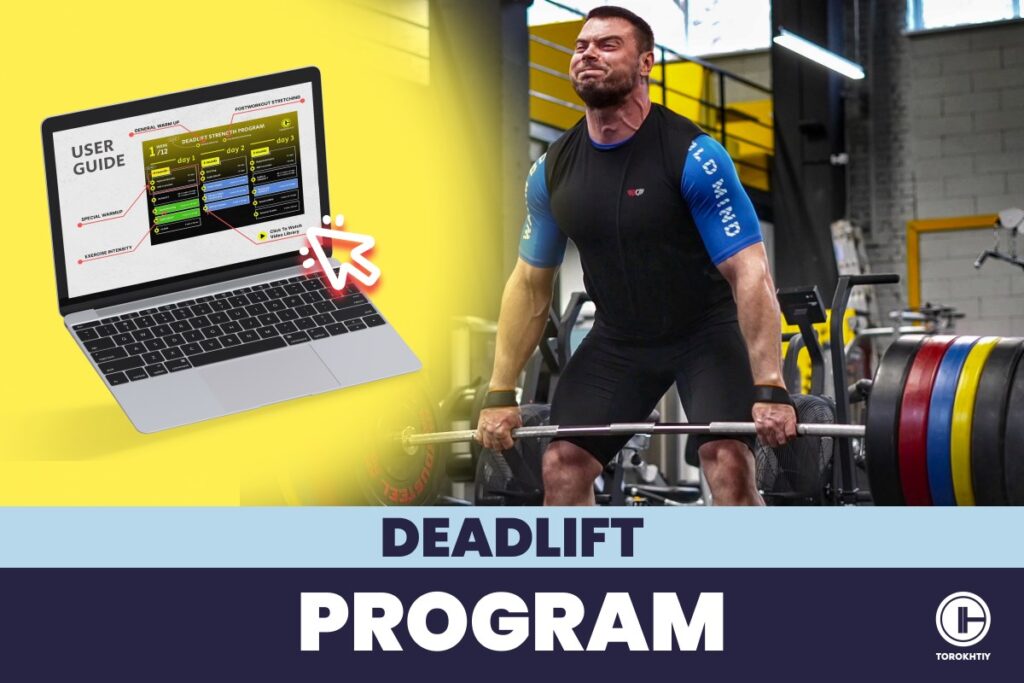
What Is a Deadlift?
The deadlift is a basic exercise which involves almost all the body muscles. Many athletes are familiar with and use this movement in their training program to develop their muscular system and strength.
Athletes often learn it as the first exercise in the gym and continue to increase the deadlift throughout their careers. Additionally, it can be found in every strength training plan in the gym.
The deadlift originally came from powerlifting. However, it is also used in Olympic weightlifting, fitness, strongman, and many other sports that have a strength component.
What Muscles Work in the Deadlift Exercise?
Deadlift is one of the most basic exercises for training and developing maximum power and strength at the same time. The main emphasis is on the largest groups – the muscles of the back and legs.
In addition, the hips, hamstrings, glutes, and lats work well in the deadlift. Trapezius, deltas, triceps, core, forearms, etc. are also actively involved in the work.
Progress in the Deadlift
Progress in the deadlift depends on the athlete’s fitness level. Let’s take a brief look at the development of the deadlift performance for each level of training.
1. Novice Deadlift Progress
For athletes whose training experience is less than 6-9 months and the training frequency is up to a 3-day deadlift program, it makes no sense to strive to set records.
Their training process in deadlift should be aimed at studying and improving the technique of all phases of movement, developing general physical fitness, and strengthening the core as well as small stabilizing muscles.
Overall, they should follow a general deadlift strength program to build their body strength capabilities to lift more in future.
2. Intermediate Deadlift Progress
Intermediate lifters perform full-fledged deadlift training programs and actively participate in competitions. They are very familiar with the technique, progress steadily, and move with their intended results. Depending on the weight category, intermediate athletes are able to reach weights equal to two body weights and more.
3. Progress in an Advanced Lifter’s Deadlift
An advanced-level athlete has more than 3 years of training experience. Most often, those who are engaged in advanced deadlift programs or other power sports professionally fall into this category.
Such athletes train under the guidance of a personal trainer and have an individualized training program, which is compiled taking into account the following aspects:
- competition schedule;
- the level of training of the athlete;
- a basic law of periodization;
- the individual characteristics of an athlete.
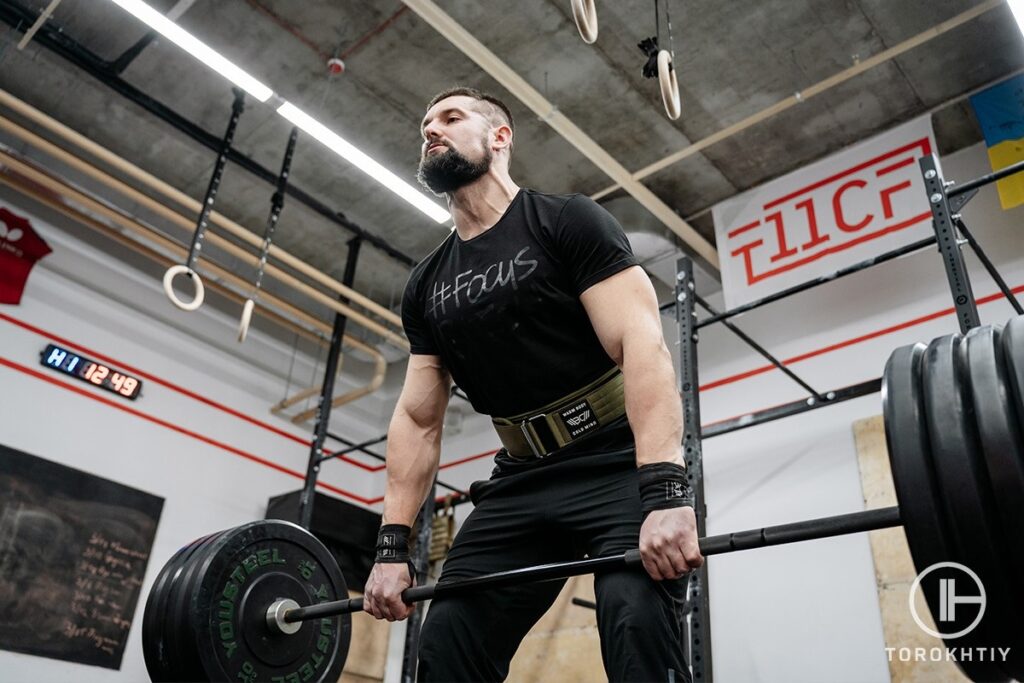
2 Key Factors in a Deadlift Program
Obviously, in order to progress, a personalized deadlift workout program is a must-have. That means you need to increase the load, and in order to become stronger, you need to purposefully develop strength. One method of developing strength is progressive overload.
In simple terms, progressive overload is the alternation of training methods that puts the athlete under stress that they have not experienced before. Adapting to that stress makes one bigger, stronger, and faster.
However, it is not just about increasing the weight of the barbell, sets, and reps, as it can also involve the following:
- frequency of training;
- prescribed number of sets and reps;
- rest time between sets.
A combination of these methods can help speed up progress and avoid deadlift plateaus. It is very important to remember that all of the above WITHOUT correct angles and technique is a direct path to injury.
1. Training Frequency
Deadlift training for maximum results always works with heavy weights. The experience of high-level powerlifters shows this type of deadlift cycle. They practice super-heavy deadlifts 1-2 times a week, and the last heavy deadlift is done 3-5 weeks before the performance.
These intervals should help you understand how important physical and mental recovery is and that it takes time. It is also important to remember that powerlifters can develop tremendous strength but often lose out to weightlifters, strongmen, and functionalists in terms of power, speed, and flexibility.
2. Intensity
Regarding deadlift training and specific load parameters, you need to remember that effective strength work is a load of 75-85% of your 1RM, for 3-8 reps.
Deadlift Training Plan for Every Grade Level
Now let’s take a detailed look at the first week of the 12-week deadlift program and then on the concept of further progress of training loads.
| Grade level | Beginner | Intermediate | Advanced |
|---|---|---|---|
| 1-week training plan | ● Training frequency is up to a 3-day deadlift program ● Aim: studying and improving the technique of all phases of movement ● Developing general physical fitness ● Strengthening the core and small stabilizing muscles ● Build body strength capabilities for further lifting | ● Full-fledged deadlift training programs ● Progress steadily, and move with the intended results ● An athlete is already able to reach weights equal to two body weights and more | ● Training under the guidance of a personal trainer ● Have an individualized training program, which is compiled taking into account: ○ Athlete’s competition schedule ○ The level of training of the athlete, his general condition |
It is important to say that most likely athletes combine deadlift programs with functional fitness or even cardio programs to make general fitness programs more harmonical.
Also some athletes use the deadlift cycle as a part of a well rounded powerlifting program. In this case they need to combine these loads with back squats and bench press loads.
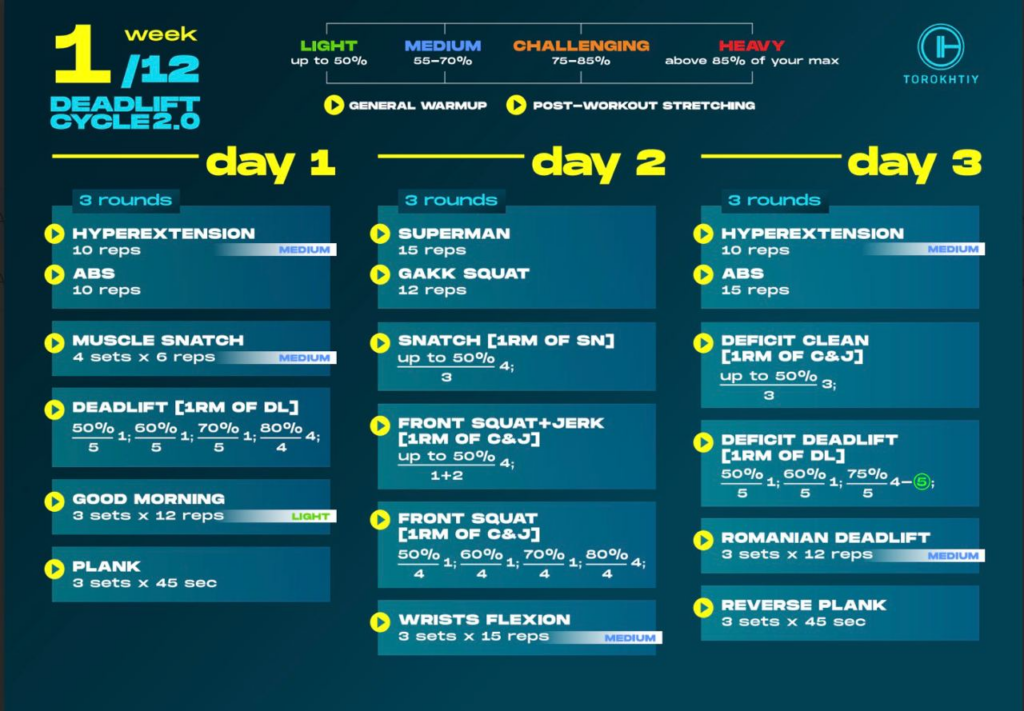
Due to high demands to recovery even elite powerlifters don`t lift weight more that 4 days a week (usually 3), but they can do some additional mobility/recovery or light cardio training in separate days.
Now let’s take at the basic deadlift week plan, which consists of 3 sessions a week. Two sessions (1 & 3) are focused on deadlift variations and session 2 is a supportive leg training day, as far as leg strength is an important factor of deadlift progress.
Every training session consist of 3 parts:
Special warmup: number of exercises for activation of core muscles (abs, deep back muscles, upper back, lats) and targeted warmup of particular joints (knees, hips). All exercises are performed in circle mode.
Main Load: mostly deadlift variations, squats, basic strength exercises
Accessory Load: jumps, plank etc.
It also can be 2 option in load prescription:
- Percentage from 1 RM – %
- For auxiliary exercises, it can be the Rate of Perceived Exertion (RPE) scale to gauge the intensity.
LIGHT: This weight won’t strain your muscles significantly. You can focus on perfecting your technique. After finishing all reps, you should feel capable of doing 4-6 more, with slight muscle fatigue, slightly faster breathing, and a slightly elevated pulse.
MEDIUM: This is a moderate working weight. You need both physical and mental concentration. After completing a set, you should have about 2-3 reps left in the tank, significant muscle fatigue, and quicker breathing.
CHALLENGING: This is a heavy working weight, requiring intense physical and mental focus. After a set, you should have only 1-2 reps left in the tank, significant muscle fatigue, and rapid breathing.
Save it for easy access!
Bookmark this page now to access the program and instructional videos anytime, anywhere.
Stop wasting time searching during your gym sessions.
Week Template
Session 1
Special warmup: 2 rounds
- Hyperextension – 15 reps
- ABS Crunches – 15 reps
Main Load:
- DEADLIFT – 60 % 2 sets x 5 reps, 75 % 5 sets x 5 reps
- Good Morning – 3 sets x 8-10 reps LIGHT LOAD
- Split SQUAT – 3 sets x 5+5 reps LIGHT LOAD
Accessory Load:
- PLANK – 3 sets x 30 sec
Session 2
Special warmup: 2 rounds
- Bird Dog – 20 reps
- Gakk SQUAT – 12 reps
Main Load:
Front SQUAT – 3 sets x 4-6 reps MEDIUM LOAD
Accessory Load:
- Biceps CURLS – 3 sets x 8-12 reps MEDIUM LOAD
- Wrists Flexion – 3 sets x 15 reps MEDIUM LOAD
Session 3
Special warmup: 2 rounds
- Hyperextension – 15 reps
- ABS Crunches – 15 reps
Main Load:
- Deficit DEADLIFT – 60 % 2 sets x 5 reps, 70 % 5 sets x 5 reps
- Romanian DEADLIFT – 3 sets x 8-12 reps MEDIUM LOAD
Accessory Load:
- Board JUMPS – 3 sets x 5-8 reps
- Reverse PLANK – 3 sets x 30 sec
So what is next?
Here is break down of each training session during upcoming 12 weeks:
Session 1: Competition Deadlift Focus
Deadlift: Gradually increase intensity by adding 2.5-5% each week.
Work in range of 4-5 working sets, and while increasing intensity drop number of working reps from 5 to 1-3. By week 8, you should aim for 85-90% of your 1RM in sets of 3 reps.
Recommended accessory exercises & load: Good Morning, Split Squat, One leg RDL, Russian TWIST, Deficit RDL + Shrugs, Plank.
Increase weight slightly but maintain a light to medium load. Put on a challenging weight not more often than once in 3 weeks if you feel you can do it today. Focus more on form and muscle activation. Work in range of 3-4 sets / 8-12 reps
Session 2: Back/Front Squat & Accessory
Squats: Progress with a 2.5-5% weekly increase. By week 8, aim for 85% of your 1RM for 3-4 reps.
Recommended accessory exercises & load: Biceps curls, Bulgarian Split Squats, Wrists Flexion, Rear Delt Fly.
Gradually increase reps or add weight. Keep the load at a moderate range, focusing on muscle endurance. Work in range of 3-4 sets / 8-15 reps
Session 3: Specific Deadlift Focus
Deadlift: Gradually increase by 2.5-5% each week. Till week 6 alternate week by week Paused and Deficit Deadlift. Starting from week 7, use Block Deadlift (knee level). Work in range of 4-5 working sets, and while increasing intensity drop number of working reps from 5 to 1-3.
Recommended accessory exercises & load: Romanian Deadlift, Pull ups, Lat Pulls, Paloff Press, Reverse Plank, Boars Jumps.
Slightly increase weight, maintaining reps in range of 3-4 sets / 8-15 reps. Prioritize form and hamstring activation.
General Guidelines:
- Increase load conservatively week by week.
- Around week 9, taper back intensity to allow recovery before max-out tests at week 12.
- Accessory exercises should focus on increasing volume or reps rather than drastically increasing load.
5 Common Deadlift Programming Mistakes
When you’re putting together a deadlift program, it’s easy to miss some key factors that can slow your progress or even lead to injury. Here are 5 common traps lifters and coaches often fall into:
❌ Skipping Periodization
Without proper periodization, your progress can stall or you might end up overtrained. You need to mix up the intensity, volume, and types of workouts to keep making gains.
❌ Focusing Too Much on Volume
High reps are great, but if you’re not lifting heavy enough, you won’t get stronger. A good program balances volume and intensity to push your limits and build serious strength.
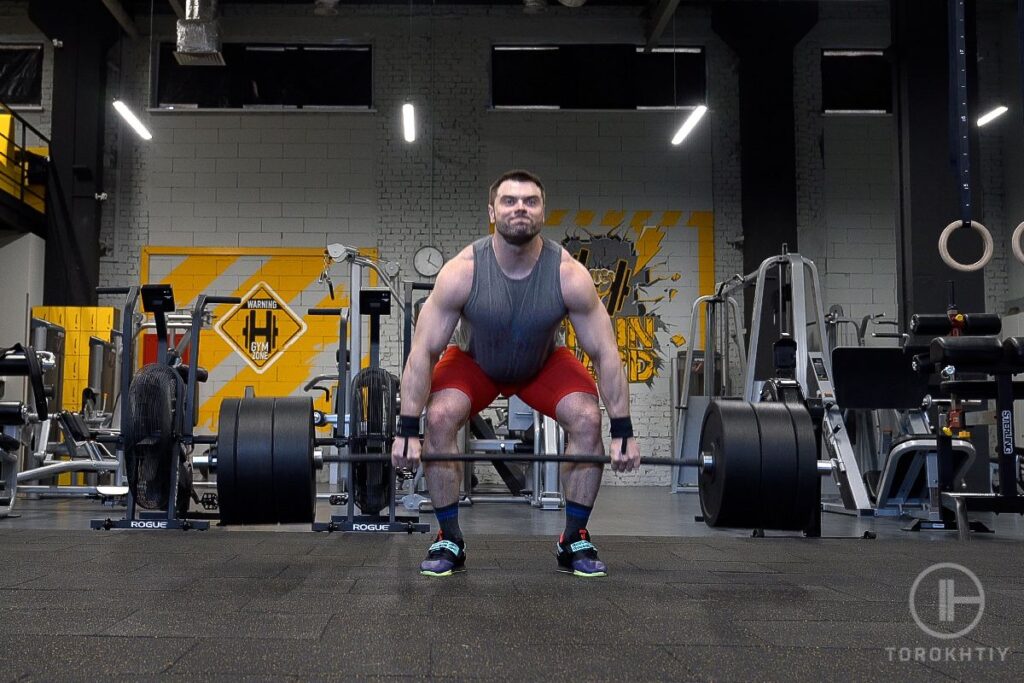
❌ Not Enough Recovery
Deadlifts are tough on your body and skipping recovery time between sessions can lead to overtraining and injury. Make sure you’re giving your body enough time to bounce back, especially when you’re lifting close to your max.
❌ Ignoring Weak Areas
If your program doesn’t address your specific weak points, you’ll hit a plateau. Whether it’s your lockout, start, or grip, include accessory work to shore up those weaknesses.
❌ Sticking to the Same Routine
Doing the same deadlift routine over and over leads to stagnation. Mix in different deadlift variations and accessory exercises to keep challenging your muscles and avoid plateaus.
8 Tips for Improving Deadlift Performance
Here are 8 top tips to improve your deadlift performance.
1. Regularity and Systematic Approach
The deadlift is a physiologically stressful exercise. You can recover from it in 48-72 hours, but for progression in the result of this exercise, it should be in the weekly plan 2-3 times a week. With a proper deadlift workout plan, you will begin feeling the progress in 6-8 weeks of systematic training.
Experienced trainers believe that in exercises such as squats, bench presses, and deadlifts, a full training cycle should last about 12 weeks or more.
2. Using an Optimal Grip
In Olympic weightlifting, there is only one grip option: the hook grip. But when we talk about basic strength training, there are many more rational options:
- regular overhand grip;
- mixed grip;
- straps and hooks.
It all depends on your training goals. If an athlete trains the deadlift as an accessory exercise for their sport, the more varied the training and grip, the more functional the strength will be.
3. Grip Strengthening
Everyone who watches powerlifting competitions knows that unsuccessful attempts by athletes happen not only because they cannot pull up the barbell but also because the weight slips out of their palms. For this reason, many strength athletes pay special attention to grip strength endurance.
There are two helpful suggestions:
- perform all the assisting exercises with a regular grip: bent over rows, pull-ups, farmer’s walk, shrugs, etc.
- on the last rep of the set, always hold at the top for 4-5 seconds to help strengthen your grip with static.
4. Increasing the Initial Speed of Movement
For pulling maximum weight, starting speed in the initial position is significant. To do this, it is important to not only pay attention to this phase of the movement but also develop strength in other auxiliary exercises:
Combined pulls:
- with varied grips (narrow, regular, medium, wide);
- with pauses or stops;
- with an explosive start;
- slow eccentric mode;
- T&G;
- variations of lunges;
- variations of jumps.
The development of strength in these exercises is an important condition for increasing the starting speed in pulling.
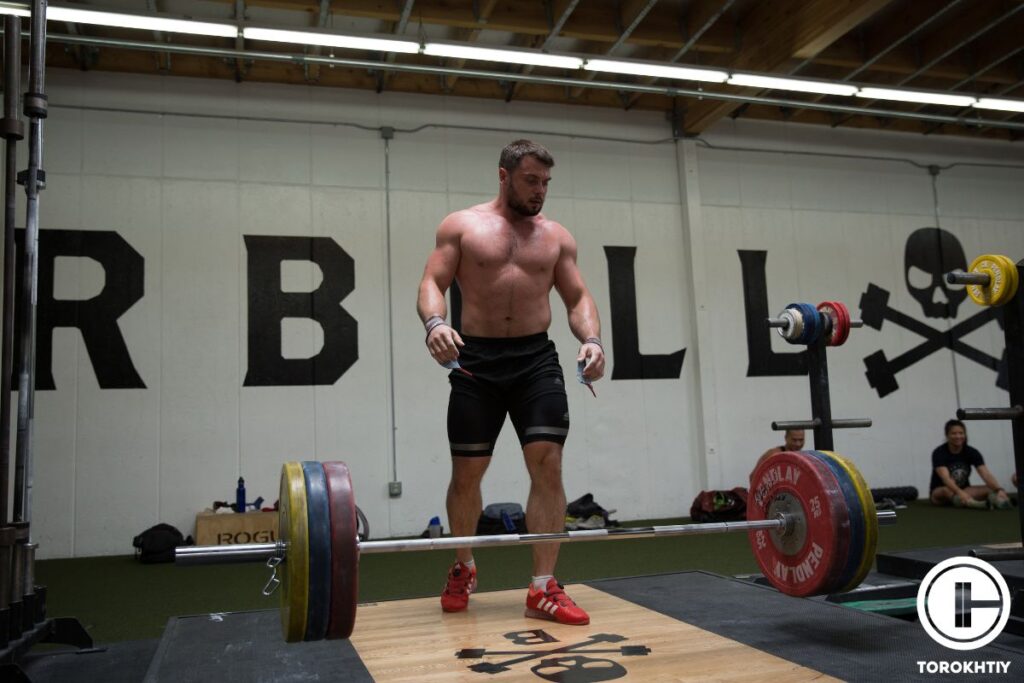
5. General Physical Fitness
The deadlift effectively develops the strength of all the muscles of the athlete’s body. However, the safe and reliable performance of the deadlift itself is impossible without an additional strengthening of smaller muscles and stabilizing muscles.
For those who dream of serious kilograms in the deadlift, it is important to regularly train the following groups of exercises:
- weighted pull-ups with different grips;
- vertical and horizontal pulls;
- farmers walk;
- squats variations;
- static and dynamic planks;
- kettlebell swings.
6. Intensity and Progressive Overload
In order to progress, you need to increase training weights, i.e. in order to become stronger, you need to purposefully develop loads. One method of developing strength is setting up a deadlift progression program.
In simple terms, it includes progressive overload, which is an alternation of training methods that exposes the athlete to specific stress that they have not experienced before. Adapting to these “unaccustomed loads” makes him more resilient, more powerful, stronger, and faster.
7. Pulling Barefoot
Performing barefoot deadlifts for an Olympic weightlifter sounds unexpected and strange, and for a fitness amateur, it will seem not like the best deadlift program but more likely as unsafe and unhygienic.
However, for powerlifters, this approach is absolutely acceptable. In fact, deadlifting without shoes is much more biomechanically rational than in any shoes.
When the lifter has no heel, the overturning action of the bar is practically absent, and the buttocks and thigh, especially the hamstrings, are turned on much more efficiently. Another detail: the trajectory of the bar is reduced. For an ordinary person, it may seem insignificant, but when you pull a world record, it matters a lot.
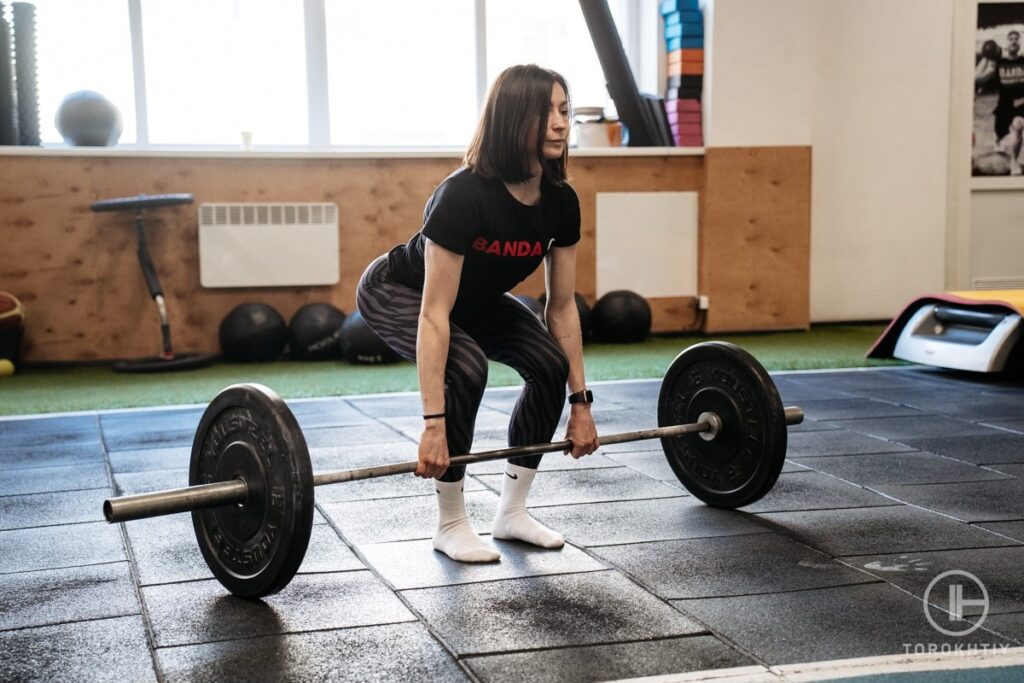
8. Mental Preparation
Never underestimate the power of mental preparation. There is an unspoken rule that at the World Championships and the Olympic Games, the first five athletes have almost the same strength level. Nevertheless, there is always one winner — the one whose nervous system remains stable in a stressful situation.
Another important aspect of mental preparation is visualization. Sports psychologists recommend that athletes play in their imagination a successful scenario of performance or performance of individual exercises or their elements while preparing for a competition. In physiological terms, this approach is called autogenic training.
What to Avoid?
For many, the deadlift seems to be a fairly technically simple exercise. In fact, however, learning the right movement is not so simple. A large number of novice athletes often make similar mistakes, and some of them can be traumatic.
❌ Rounding Back
Rounding back is a common mistake among both beginners and experienced athletes. The back can round out if the lifter releases the bar forward during the upward movement and, as a result, the center of gravity moves to the forefoot.
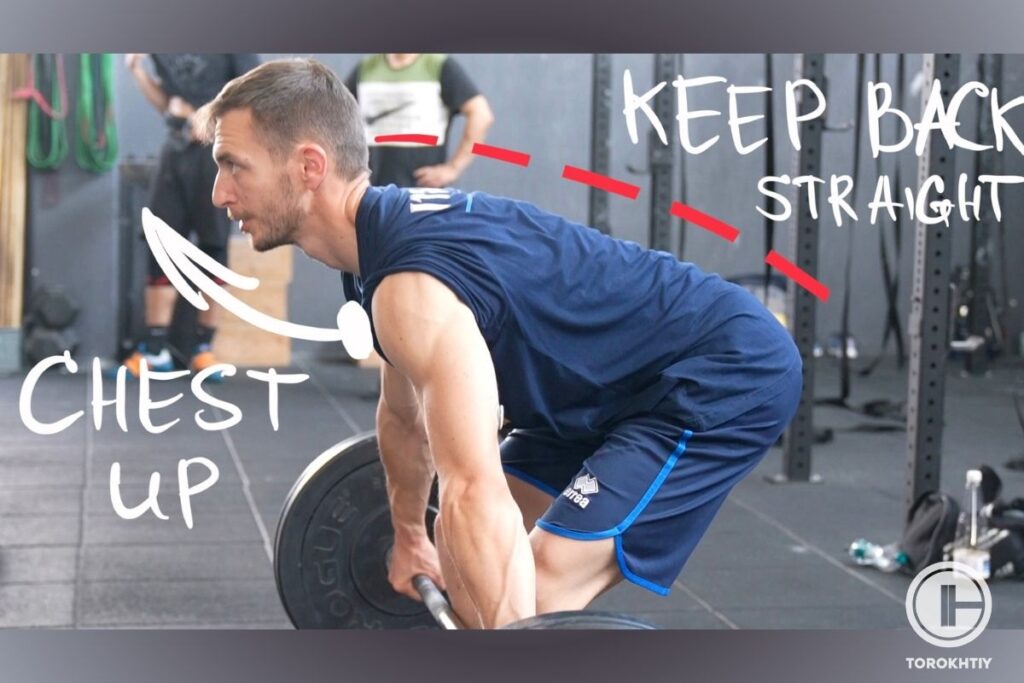
Another reason for rounding the back can be an incorrect starting position: when the athlete’s hips are too high and the entire load is shifted to the back as much as possible.
In addition, this error can occur if the athlete has not arched enough and strained the lower back and back muscles in the starting position. This skill is essential to keep your torso in the correct position throughout the entire pull.
A practical advice: do not try to lift a weight with which you are not able to follow all the technical rules. This risk is absolutely not justified, especially if you are engaged in weightlifting fitness, where, as a rule, there is no goal to perform this exercise to the maximum.
❌ Overextension During Fixation
Overextending the trunk back can lead to spinal injury. Therefore, the athlete must ensure that his position is as vertically straight as possible. This position must be held for about a second to fix; subsequently, the bar must be correctly lowered onto the platform.
Athletes must always remember that this fixation phase ends when the knees and back are straightened but the torso is not tilted back.
❌ Release The Bar Forward
When an athlete releases the bar forward, it causes a lot of dangerous and unnecessary leverage in the body. With this position and angles, the spine receives a very large load and compression of the lumbar discs, which can injure them. To minimize the risk of this mistake, always pull the barbell as close to your shins and thighs as possible.
❌ Wrong Projection Of The Bar
Both in the starting position and in the deadlift, the projection of the bar should be in the middle of the foot. If this balance is shifted further forward or backward, the entire biomechanics of the pull is disrupted. In this case, the athlete is more likely to make the mistake we discussed first on this list.
❌ Too Narrow Grip
The optimal grip width in the classic deadlift should be slightly wider than the width of the feet. If an athlete performs an exercise with grip that is too narrow, it can provoke a number of more errors. For example, the arms may be bent at the elbows to make room for the knees in the starting position.
With this technique, there is a strong tension in the muscles of the arms, which significantly increases the risk of injury and rupture of the biceps.
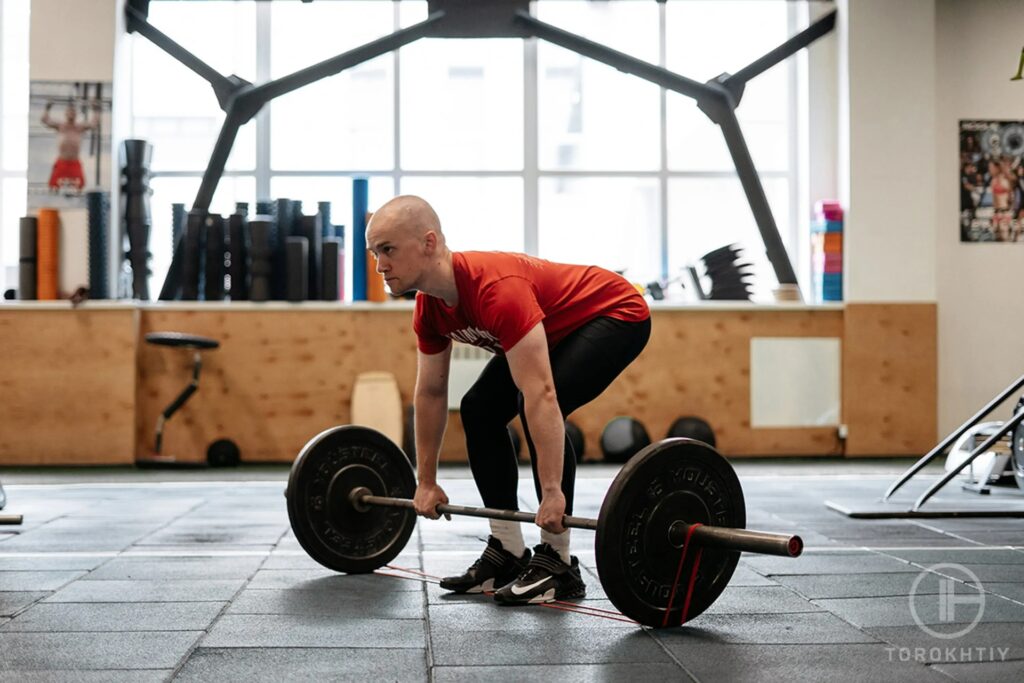
5 Deadlift Variations
Each variation of the deadlift program serves to achieve a slightly different result. Let’s take a look at the most common variations below:
1. Sumo Deadlift
This variation is mostly used in professional powerlifting deadlift routines. The technique of this exercise is more complicated than the classic deadlift. The main difference is that the athlete puts his feet as wide as possible and grabs the barbell with a shoulder-wide grip.
This technique significantly reduces the range of motion and more actively involves the muscles of the legs in comparison with the classical technique.
2. Romanian Deadlift
The Romanian deadlift (RDL) is a popular pull variation that is performed with almost straight legs. It helps to train the hamstrings, glutes, and erectors of the spine more effectively.
RDL is a variation of the deadlift that focuses on the posterior chain muscles and helps to increase the size and strength of the hamstrings, glutes, and erectors of the spine.
This variation is included in the deadlift training program of almost all strength athletes as the easiest and most effective way to work out the back of the body. As for other sports, it is often used as an auxiliary exercise. For example, strong spinal erectors are important for snatch and C&J, while hamstrings are critical for fast running and jumping.
3. Snatch Grip Deadlift
Snatch grip deadlift is ideal for Olympic weightlifters. This variation is almost a deadlift from the floor but executed with a wide grip. Its technique has almost the same structure as the traditional snatch exercise pull, but there is no power position and calf raise.
This exercise gives good results in increasing the strength of the upper back and lower body but without the phase of explosion.
Certain weightlifters choose snatch grip pulls as it puts less strain on the lower part of the back. The snatch deadlift is the main drill training of the snatch for strength development, balance, and movement control.
Follow us!

Free!
Get a 2-week Weightlifting Program as a bonus for the subscription to kickstart your training plan!

Free!
Weightlifters typically perform snatch deadlifts with heavier loads in comparison to snatch, which helps them develop specific strengths. The deadlift with snatch grip can be used as a corrective exercise with low loads to correct body position and angles or as an instrument for learning the snatch.
The snatch Olympic deadlifting involves almost the same muscles as the classical deadlift. However, due to the wide grip, it applies more stress on the upper part of the back than on the lower back. The snatch-style deadlift is a longer exercise than the classic deadlift.
A wide-style grip makes the athlete drive his hips back to complete the exercise. It targets the hamstrings and upper part back and can be effective for progressing with other drills, including classic pull.
To keep increasing the deadlift, you must do a similar load for a few weeks, which is usually achieved by adding weight, volume, and intensity each week. Keep in mind that linear and easy progress will one day end; subsequently, a variety of exercises can be planned to overcome the plateau.
It also helps you mentally. Any changes and updates in the usual routine make workouts way more exciting. It may seem obvious, but enjoying your sessions is critical to sticking with a training cycle for the long haul.
4. Trap Bar Deadlift
This variation is performed with special equipment. It helps to more evenly distribute the load between the legs and back and, therefore, is more comfortable and safer for the lower back. This makes the trap bar deadlift one of the best choices for a beginner deadlift program.
5. Deadlift from a Deficit Position
This variation is performed from an additional platform of regular weight-lifting plates. You can vary the height to make the exercise more difficult. The deficit deadlift aims to improve breakaway technique and starting speed and teaches you to use all the important muscles and correctly distribute the load between them.
Try Our Programs to Achieve New Result
If you would like to work more on your deadlift, try our program to improve your technique or gain a new personal best.
DEADLIFT 2.0 is a 12-week Olympic weightlifting training program designed to peak your deadlift to hit a new personal record.
Technique in the Deadlift for Beginners and Intermediate to Advanced Lifters
The deadlift comprises 4 main phases:
- starting position;
- pull;
- lockout;
- descending.
Below you can find a detailed description of each phase of the deadlift exercise, including its characteristics, advantages, drawbacks, and performance techniques.
1. Starting Position
After the athlete has approached the bar, they must correctly set the feet. To do this, the athlete needs to put feet shoulder-width apart, and the projection of the bar passes through the middle of the foot. The bar should be as close as possible; touching the shin is allowed.
In the classic deadlift, the standard grip is slightly wider than the setting. There are three most common barbell grip options: overhand, mixed, and hook.
The overhand grip is the simplest one in terms of technology. Nonetheless, this grip has an important drawback: for many athletes, in the process of movement, fingers open underweight, and the bar simply rolls out.
However, it does not mean that this grip is useless: to secure the bar, many athletes use straps, metal hooks, leather and synthetic training gloves, and other accessories that help solve the problem of grip stability.
The mixed grip is used not only in professional powerlifting but also in the strength training of athletes and mass fitness. When grabbing the bar, the athlete holds the bar from below with one hand and from above with the other.
This technique significantly increases the reliability of the grip. The disadvantage of the mixed grip is the asymmetric distribution of the load and, as a result, the muscular imbalance of the right and left parts of the body, i.e. different muscle development of the arms, shoulders, or back.
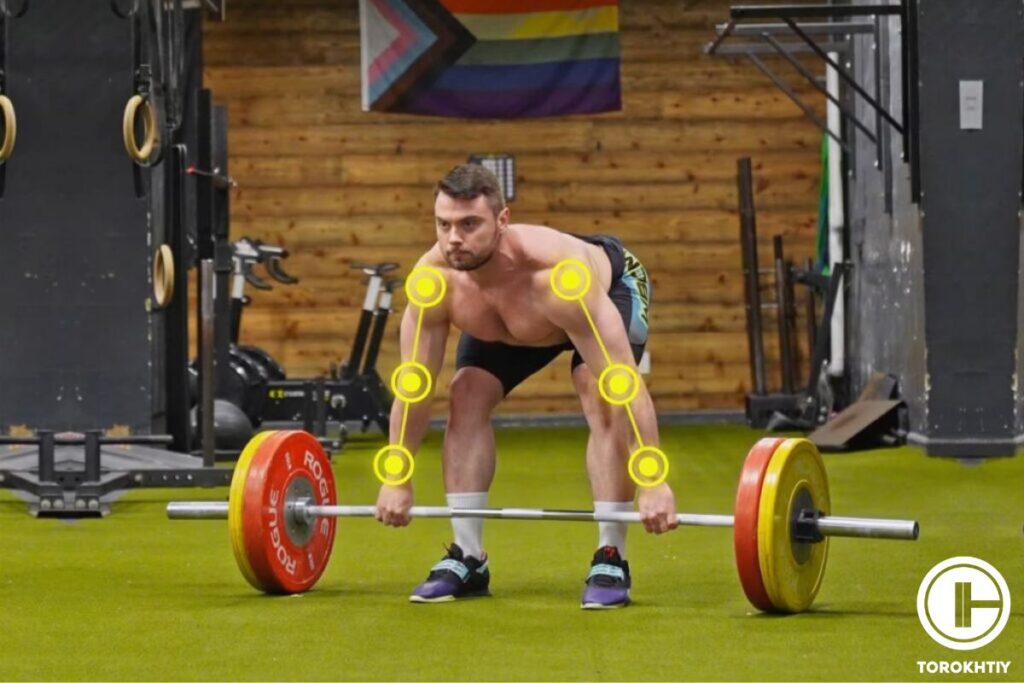
The hook grip is the optimal solution primarily for professional weightlifters as well as athletes of other sports. With this technique, the athlete wraps their fingers around the bar and thumb. This approach allows one to hold large weights and keep arm muscles as relaxed as possible.
Although this grip can cause some pain, all athletes get used to it and feel that this position is quite natural.
After placing the feet and arms correctly in the starting position, it is necessary to place the torso and legs. The back must be arched and tense. The legs must be bent at the knee and hip joints, so that the pelvis is approximately in line with the knees.
The shoulders should be positioned above the bar or slightly cover it. The gaze should be directed forward, while the neck should be in a neutral position.
2. Pull
After the athlete has taken a correct and comfortable starting position, they need to perform several more important preparatory actions. It is necessary to bend the lower back, open the chest, and bring the shoulder blades together.
A movement starts with the legs. It is important to not just strive to lift weight but push the platform away with the maximum force.
During the exercise, maintain the position of the shoulders above the bar and synchronously unbend the back and legs. After the bar has passed the level of the knees, it is necessary to actively engage and compress the gluteal muscles.
To maintain an economical and efficient trajectory, the athlete must pull the bar as close as possible. It is allowed to touch the legs throughout the entire trajectory. If the lifter lets the weight go away, then there is a risk that their back will round and the whole biomechanics of movement will break.
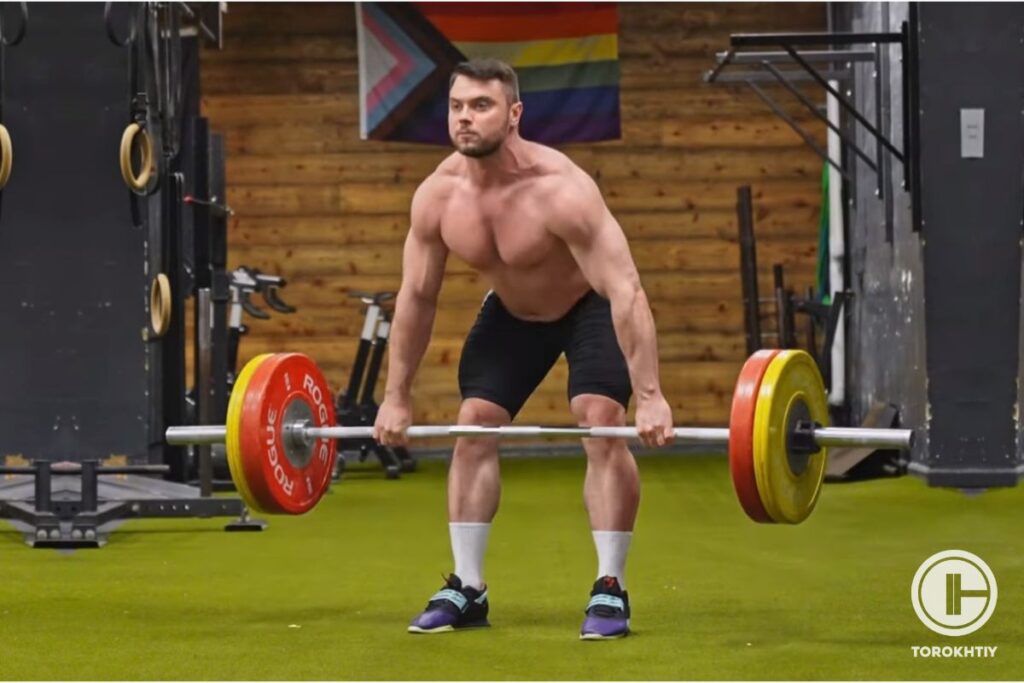
3. Lockout
The pull is considered completed after the full extension of the knee and hip joints. Overextending the trunk back can lead to spinal injury. Therefore, the athlete must ensure that their position is as vertically straight as possible. This position must be held for about a second to fix; afterwards, the bar must be correctly lowered onto the platform.
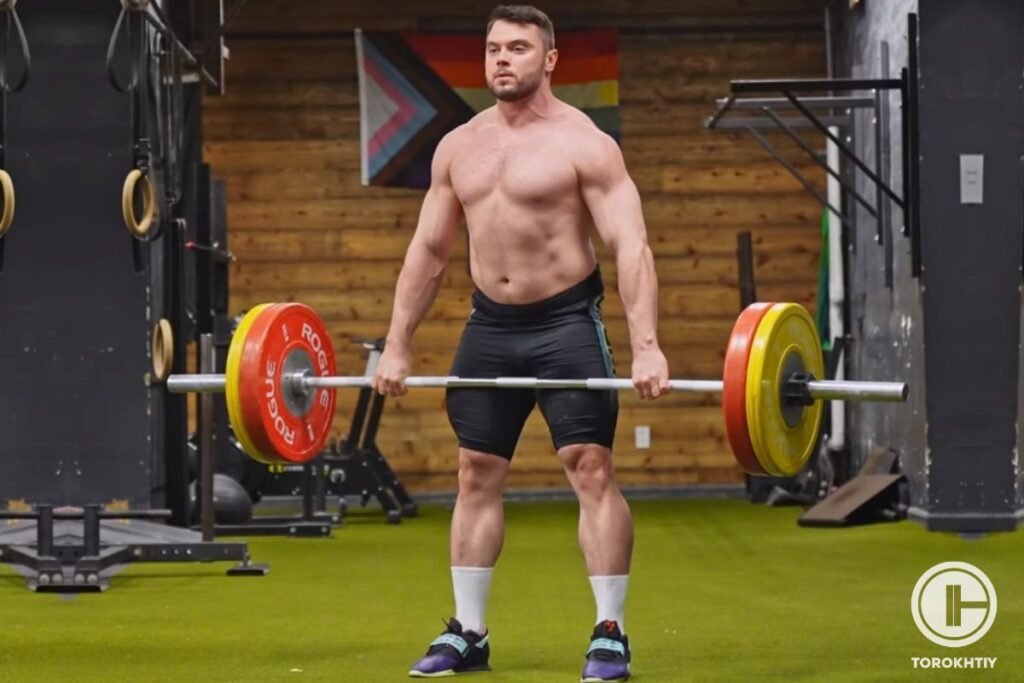
4. Descending
Lowering the barbell must be done in a controlled manner. In fact, the lifter must copy the path of the bar up when moving down. You cannot relax the muscles immediately after fixation and throw the barbell onto the platform, as it can lead to unpleasant consequences and even injury.
Moreover, in a competition, if the lifter has not escorted the barbell down to the platform, the judges will not count the attempt as a good lift.
Lastly, if the pull is performed for a large number of repetitions, you need to maintain back tension throughout the entire set.
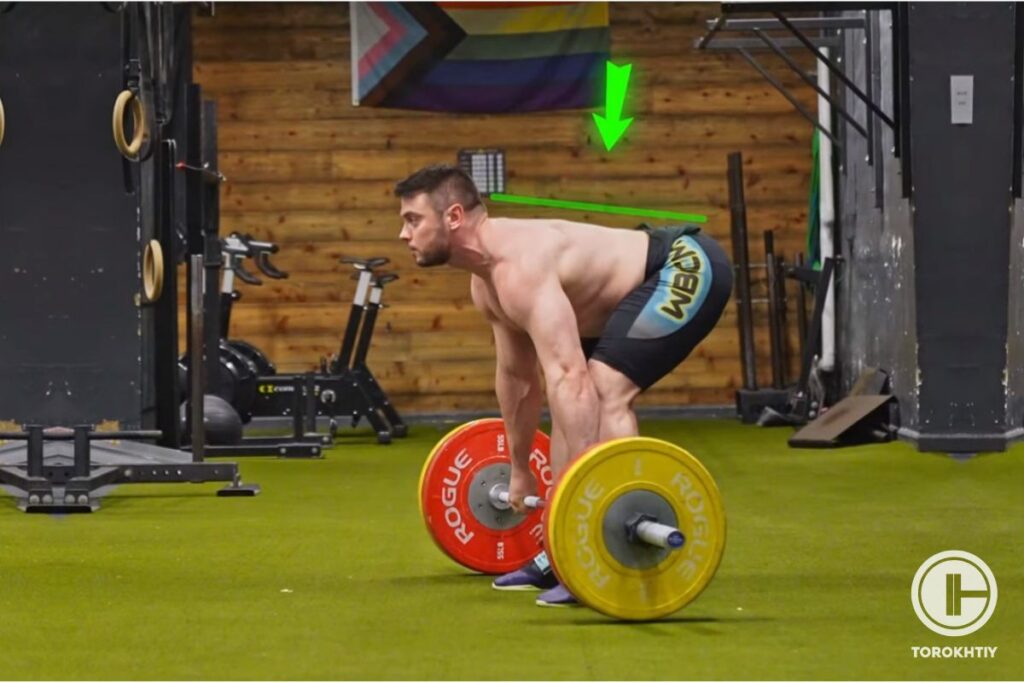
6 Deadlift Advantages
Let’s take a look at the main benefits that can be achieved by performing regular deadlifts.
✅ The Hip Extensors Activation
The deadlift and its variations are the best exercises for hip extension training. These muscles include the gluteus maximus and the hamstring.
✅ Explosive Power and Jump Development
Jumping is a key skill for many sports. The quality of the jump integrally reflects the development of the strength of the lower body. In addition, jumping power is transferred to other activities with maximum power, such as sprinting.
✅ Increased Bone Density
Decreased bone mineral density is a common problem with aging, which can lead to osteoporosis, greatly increasing the risk of fractures in the elderly. A large amount of scientific research supports the use of resistance training to slow bone density loss, including exercises such as deadlifts.
✅ Strengthening the Muscles of the Trunk
Coaching experience and research have shown that the deadlift and other free-weight strength exercises are an effective way to activate and strengthen the core muscles that stabilize the spine.
✅ The Metabolism Acceleration
Weight loss is a common goal of many fitness programs. Qualitatively, losing weight through fat requires a person to burn more calories than they consume. When it comes to effectively boosting your metabolism through movement, strength training with exercises like the deadlift is one of the most effective methods.
✅ Minimum Number of Equipment
An important advantage of the deadlift is the simplicity of the equipment. All you need is a barbell and some discs to complete the movement.
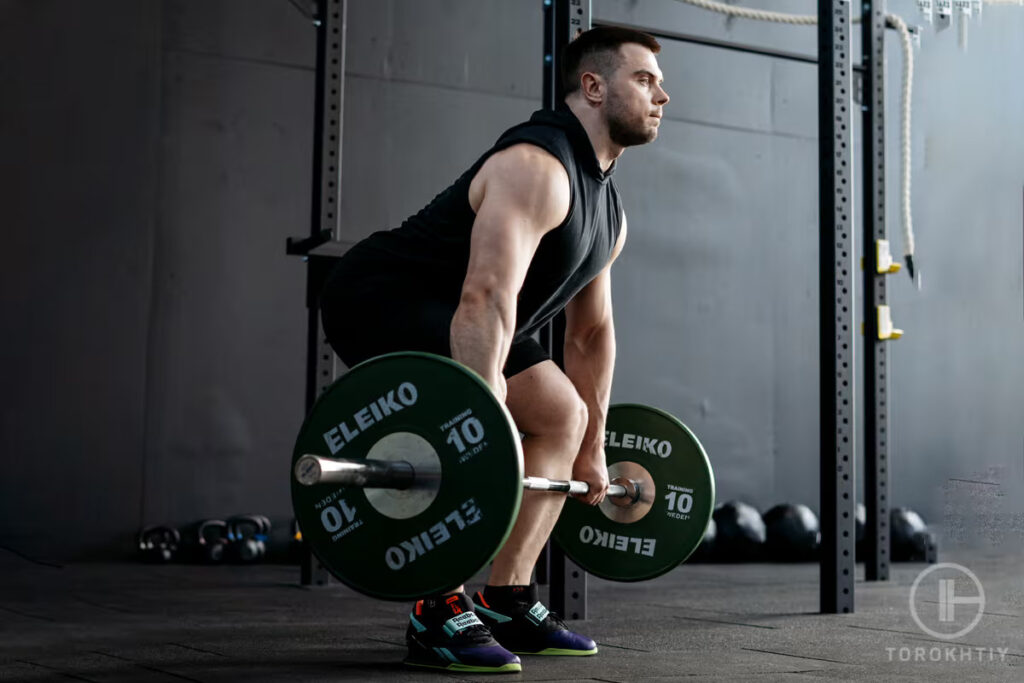
FAQ
How Many Days a Week Do You Deadlift?
It depends on your fitness level: a beginner can train one to three times a week, with a longer period for recovery between exercises. While an experienced athlete who has already been training regularly and has already been performing deadlifts can work out five or six times a week. Recovery time can be decreased.
Are 3 Sets of 6 Good for Deadlift?
Yes, it is considered to be a standard number of sets and reps. Generally, you should choose a set and rep range, and weight according to your capabilities. For strength training, it is recommended to perform 3-4 sets of 2-6 reps. For building muscle mass, it is better to do more – 4 sets of 6-12 reps will be enough.
Conclusion
Pick up your surefire way to improve your sports performance, particularly excelling at deadlifting with a properly selected deadlift workout plan. Master your pulling technique, hit your personal record in deadlift, and build up raw power under the guidance of top sportsmen and Olympic weightlifters.
Also read:
- Average Deadlift
- Deadlift Stances
- Bad Deadlift Form
- Is Sumo Deadlift Easier
- Rack Pull vs Deadlift
- Deadlift Bar Weight
- Deadlift Progression
- Deadlift Hook Grip
References:
- Giuseppe Coratella, Gianpaolo Tornatore, Stefano Longo, Fabio Esposito, Emiliano Cè, “An Electromyographic Analysis of Romanian, Step-Romanian, and Stiff-Leg Deadlift: Implication for Resistance Training,” International Journal of Environmental Research and Public Health 19, no. 3 (2022): 1903. https://www.ncbi.nlm.nih.gov/pmc/articles/PMC8835508/
- Isabel Martín-Fuentes, José M. Oliva-Lozano, José M. Muyor, “Electromyographic Activity in Deadlift Exercise and Its Variants. A Systematic Review,” PLoS One 15, no. 2 (2020): e0229507. doi: 10.1371/journal.pone.0229507
- Iván Chulvi-Medrano, Xavier García-Massó, Juan C. Colado, Carlos Pablos, Joao Alves de Moraes, Maria A. Fuster., “Deadlift Muscle Force and Activation Under Stable and Unstable Conditions,” The Journal of Strength & Conditioning Research 24, no. 10 (2010): 2723-2730. DOI:10.1519/JSC.0b013e3181f0a8b9
- Mark E. Hammer, Rudi A. Meir, John W. Whitting, Zachary J. Crowley-McHattan, “Shod vs. Barefoot Effects on Force and Power Development during a Conventional Deadlift,” Journal of Strength and Conditioning Research 32, no. 6 (2018): 1525-1530. DOI:10.1519/JSC.0000000000002246
- Rafael F. Escamilla, Anthony C. Francisco, Andrew V. Kayes, Kevin P. Speer, Claude T. Moorman III, “An Electromyographic Analysis of Sumo and Conventional Style Deadlifts,” Medicine & Science in Sports & Exercise 34, no. 4 (2002): 682-688. https://journals.lww.com/acsm-msse/Fulltext/2002/04000/An_electromyographic_analysis_of_sumo_and.19.aspx
- Ulrika Aasa, Victor Bengtsson, Lars Berglund, Fredrik Öhberg, “Variability of Lumbar Spinal Alignment among Power- and Weightlifters during the Deadlift and Barbell Back Squat,” Sports Biomechanics 21, no. 6 (2022): 701-717. DOI:10.1080/14763141.2019.1675751
- All photos are made by Torokhtiy Media team.
Why Trust Us?
With over 20 years in Olympic weightlifting, strength training, nutrition coaching, and general fitness our team does its best to provide the audience with ultimate support and meet the needs and requirements of advanced athletes and professional lifters, as well as people who strive to open new opportunities and develop their physical capabilities with us.
By trusting the recommendations of our certified experts in coaching, nutrition, and sports training programming, as well as scientific consultants, and physiotherapists, we provide you with thorough, well-considered, and scientifically proven content. All the information given in the articles concerning workout programming, separate exercises, and athletic performance, in general, is based on verified data.
The product testing process is described in more detail here.
Author: Oleksiy Torokhtiy
Olympic Weightlifting Champion, PhD in Sport Science
Best Results: Snatch – 200 kg,
C&J – 240 kg
Oleksiy Torokhtiy is a professional athlete boasting 20 years of experience in Olympic weightlifting. With multiple European and World titles under his belt, he has showcased his prowess in two Olympic Games (Beijing 2008 and London 2012). Upon concluding his illustrious career, Oleksiy dedicated himself to coaching. By 2022, he had conducted over 200 weightlifting seminars worldwide. He is the visionary behind an international sportswear and accessories brand known for its motto, “Warm Body Cold Mind.” Additionally, he is an esteemed author and the creator of a series of training programs and eBooks.



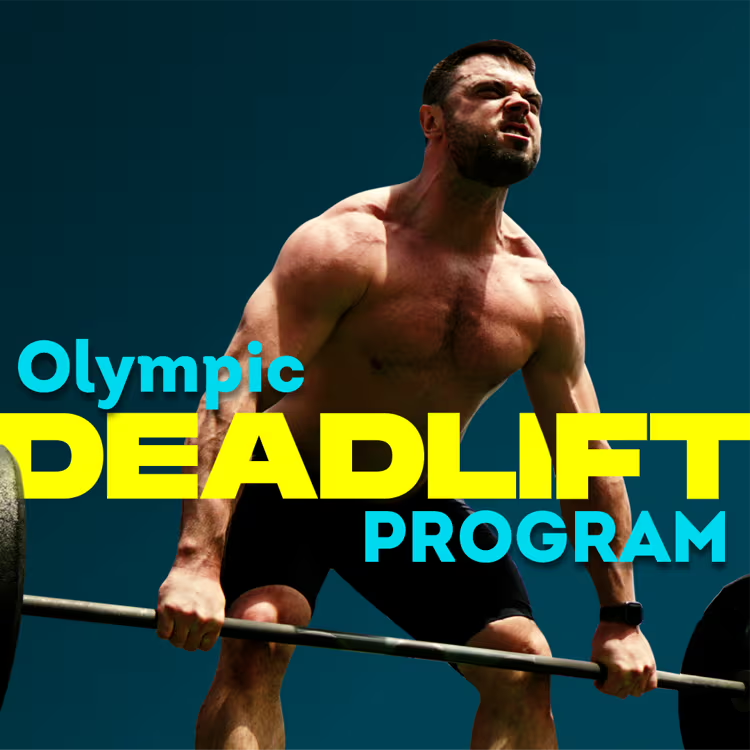
Still have questions after reading our article? Unlock your full potential by engaging with our experts and community! Don’t hesitate — leave a comment below and Oleksiy Torokhtiy will provide a personalized answer and insights to help you reach your goals.